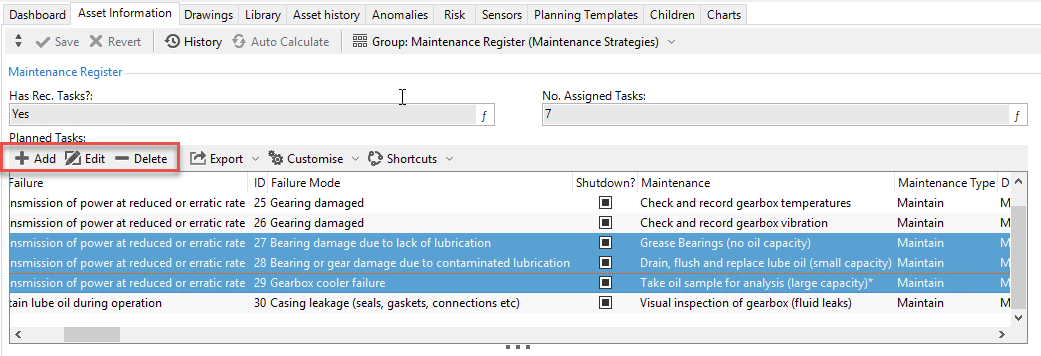Asset Information Groups (AIGs)
Asset Information Groups (AIGs) are preconfigured sets of fields used to record asset-specific data. You can access and manage AIGs on the Asset Information tab, which is available on both the ASSETS and INSPECTION screens. The functionality is identical in both locations.
Before entering data, ensure that:
The AIG has been set up (see Configure Asset Information Groups)
The AIG has been assigned to the asset type of the selected asset (see Assign AIGs to an Asset Type)
Using the Asset Information Tab
To learn about the different field types available on this tab, see Field Types.
You can interact with the Asset Information tab using the tab’s toolbar options:

Select or switch AIGs: Click the Group toolbar button and select the required AIG.
Navigate between AIGs: Use the arrow buttons next to the Group button. Navigation follows the order defined in the asset type configuration (see Ordering groups).
Toggle tab location: Click the
button to move the tab:
Among other asset tabs (for example, Dashboard, Drawings)
To the bottom of the window, below the other tabs.
This allows you to view asset information alongside other data or maximise the window space for the data you’re interested in.
Save or discard changes: After making changes, the
Save and
Revert buttons become active, which you can use to save or discard your changes. If you switch assets without saving or reverting, your changes will be saved automatically.
View history: Click the
button to open the History dialog for the current AIG on the selected asset. (see Checking History).
For detailed information about editing AIGs, see Edit AIGs (Individually/in Bulk).
Tip
If you are navigating through the asset tree and the Asset Information tab is not important, you can select a different tab, such as Library. This prevents asset information from being loaded, which can be useful if the asset information involves extensive calculations.
Ordering groups
The order of asset information groups determines which group is shown by default. When switching to a new asset on the ASSET screen, the previously active group will remain active if it also belongs to the new asset. If the previous group is no longer applicable, the default AIG (ordered highest on the list) will be shown.
To reorder AIGs:
Go to Configure Asset Types
Edit the relevant asset type.
Go to the Asset Information Groups tab.
Adjust the order using the up/down buttons.
Field Types
For information about the various field types available in an AIG form, see Field Types.
Sub-Asset Information Groups
Often, you will need to record a list or table of information for a single asset. For example, you might have a list of various threats that apply to this asset, along with their severity levels.
To represent this, we use a sub-form within the form.
Note
To view sub-asset groups for multiple assets, use the Children tab to select multiple sub-asset information groups. This provides the ability to bulk update sub-asset information across multiple assets simultaneously.
You can use Add, Edit, and Delete to add, edit, or remove rows.
By ctrl-clicking sub-asset information rows, you can edit or remove multiple rows at once. See the screenshot below for an example:
